The Figworts or Scrophulariacea is a family wich has many introduced ornamental plants, through planting in the garden. It used to be much larger but has been split since the new molecular system of classification (APG III) came into place.
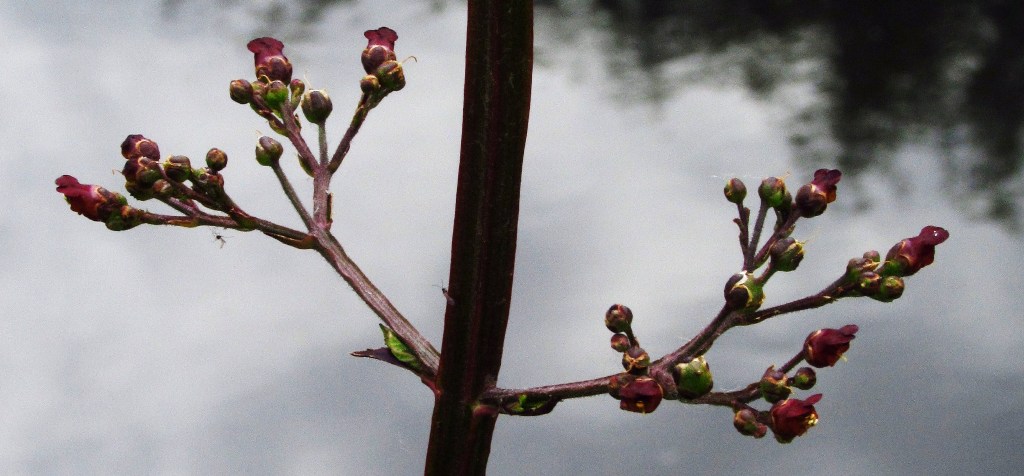
The name Figwort is only just represented by the genus Scrophularia in the B.I..
The individual genera of Scrophulariaceae are all unique in their general appearance. The uses are mainly for wildlife and garden plants, but the Figworts and Mulleins also have medicinal uses which you can read up about on the next page.
It has been split into four additional families:
- Paulowniaceae,
- Phyrtmaceae,
- Calceolariaceae and last
- Veronicaceae.
Other changes are:
- The semi-parasitic Pedicularieae has been moved to the Orobanchaceae family.
- The Buddlejaceae are now amalgamated with the Scrophulariaceae.
Hopefully more about those families in future blogs.
More info and pictures can be found through the links provided. The pictures used in this post are by Mike Poulton (M.P.) of Ecorecord and Rudi Pilsel (R.P.), Derrick Forster, Matt Summers (M.S.) as well as from Wikipedia Common.
If the plants are found in the Flora of Birmingham and the Black Country a FBBC will be added behind the Common name in the contents page below.
Contents:
Verbascum or Mulleins
- V. blattaria or Moth Mullein FBBC
V. virgatum or Twiggy Mullein FBBC
- V. phoeniceum or Purple Mullein (Introduced & Naturalized)
- V. pyramidatum or Caucasian Mullein
- V. bombyciferum or Broussa Mullein FBBC
- V. phlomoides or Orange Mullein FBBC
- V. densiflorum or Dense-flowered Mullein FBBC
V. thapsus or Great Mullein FBBC
- V. chaixii or Nettle-leaved Mullein
V. nigrum or Dark Mullein FBBC
- V. speciosum or Hungarian Mullein (probably the finest species according to Stace)) FBBC
V. pulverulentum or Hoary Mullein FBBC
V. lychnitis or White Mullein FBBC
Scrophularia or Figworts
4 native and 3 Introduced & Naturalized species
S. nodosa or Common Figwort FBBC
S. auriculata or Water Figwort FBBC
S. umbrosa or Green Figwort
S. scorodonia or Balm-leaved Figwort
- S. scopolii or Italian Figwort
- S. vernalis or Yellow Figwort FBBC
- S. peregrina or Mediterranean Figwort
Phygelius capensis or Cape Figwort FBBC
Chaenostoma cordatum (syn. Sutera cordata) or Bacopa FBBC
Nemesia strumosa or Cape Jewels FBBC
Limosella aquatica or Mudwort FBBC
L. australis or Welsh Mudwort
Buddleja or Butterfly-bushes
- B. davidii or Butterfly-bush FBBC
- B. alternifolia or Alternate-leaved Butterfly-bush FBBC
- B. x weyerana or Weyer’s Butterfly-bush FBBC
- B. globosa or Orange-ball-tree FBBC
Diascia barbarae or Twinspur FBBC
Verbascum or Mulleins
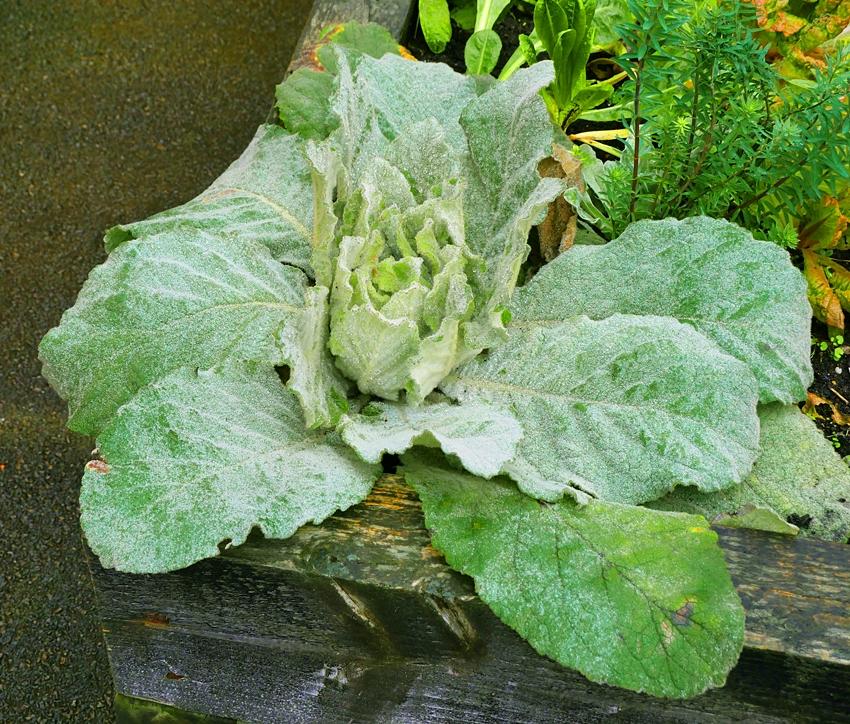
Verbascum is a genus of over 450 species of flowering plants, common name Mullein, in the figwort family Scrophulariaceae. They are native to Europe and Asia, with the highest species diversity in the Mediterranean. There are 13 species mentioned in Stace with also many hybrids, which makes identification of individual species even more of a challenge!
Only a few are native to B.I. . The ones, in small letter, are introduced and naturalized often through being grown in gardens. These are called neophytes.
Mullein or “mullein leaf” often refers to the leaves of Verbascum thapsus, the great or common mullein, which is frequently used in herbal medicine.
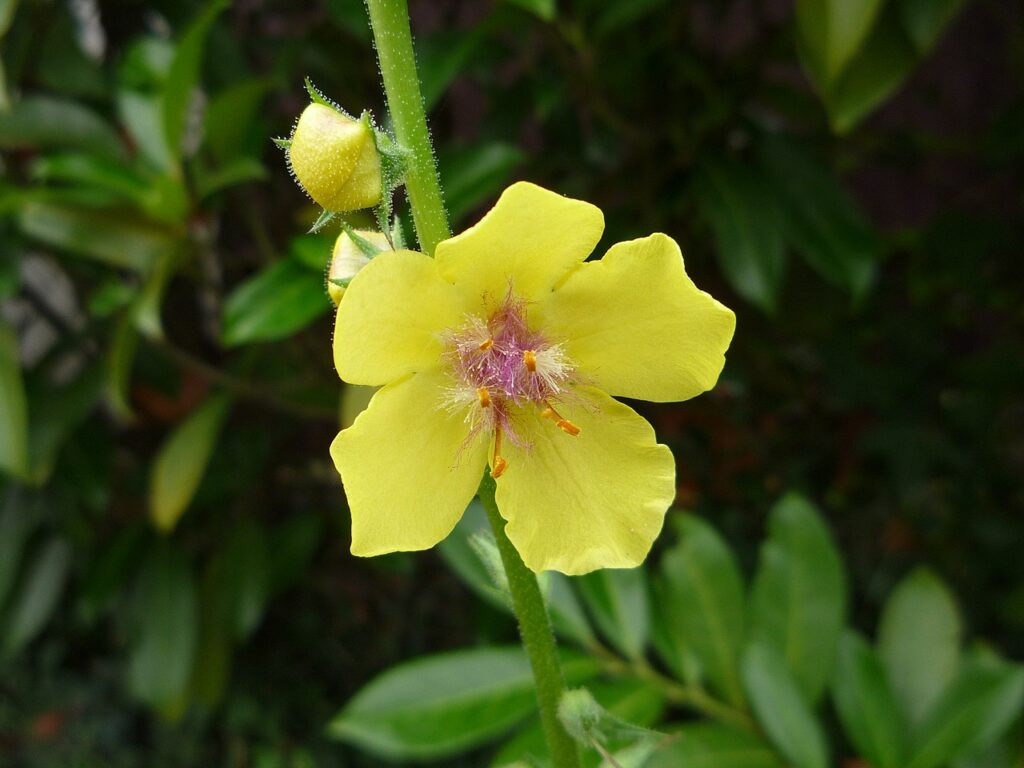
A biennial, occasionally annual, herb of waste ground, rough grassland, field-borders and waysides; also in old quarries and gravel-pits. Occurrences are generally casual, but some populations appear to be persistent.
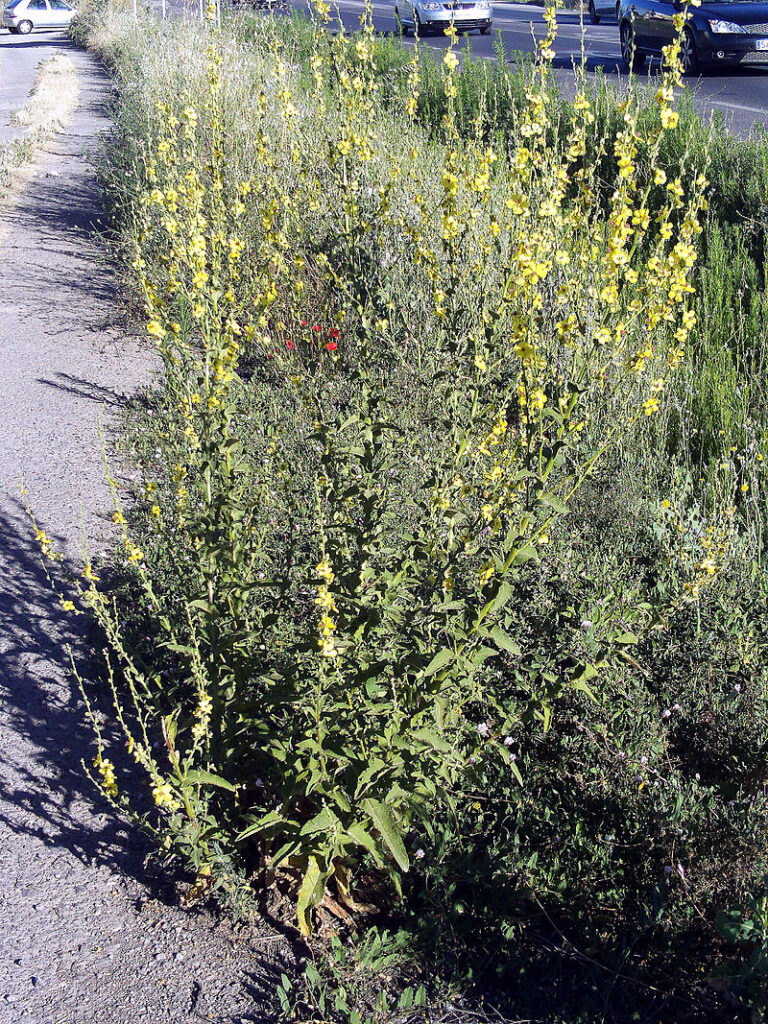
V. virgatum or Twiggy Mullein (Neophyte)
A biennial herb, naturalised on dry banks, walls, field margins, rough grassland, pastures and sheltered sea-cliffs in S.W. England; elsewhere a casual of waste ground, rubbish tips, re-seeded road verges, sand-pits, tracks and disturbed coastal dunes. It reproduces by seed, easily colonising open habitats, but does not survive much competition.
- V. phoeniceum or Purple Mullein (Casual)
- V. pyramidatum or Caucasian Mullein
- V. bombyciferum or Broussa Mullein
- V. phlomoides or Orange Mullein (Neophyte)
- V. densiflorum or Dense-flowered Mullein (Neophyte)
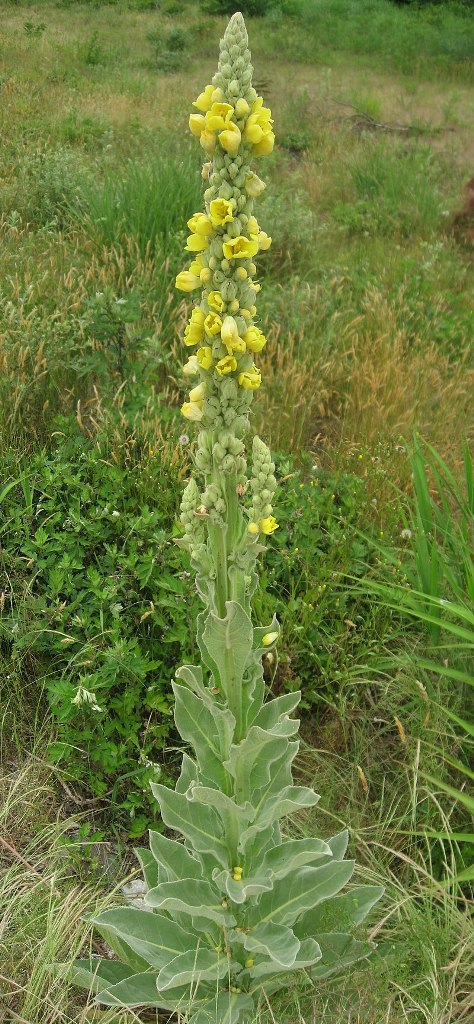
V. thapsus or Great Mullein
A biennial herb of open scrub and hedge banks, waysides, railway banks and sidings, rough grassy places, waste ground and quarries. It prefers well-drained soils, especially those over a sand, gravel or chalk substrate. It produces copious long-lived seed and may become an abundant colonist. It is a frequent garden escape, becoming established on rubbish tips when thrown out.
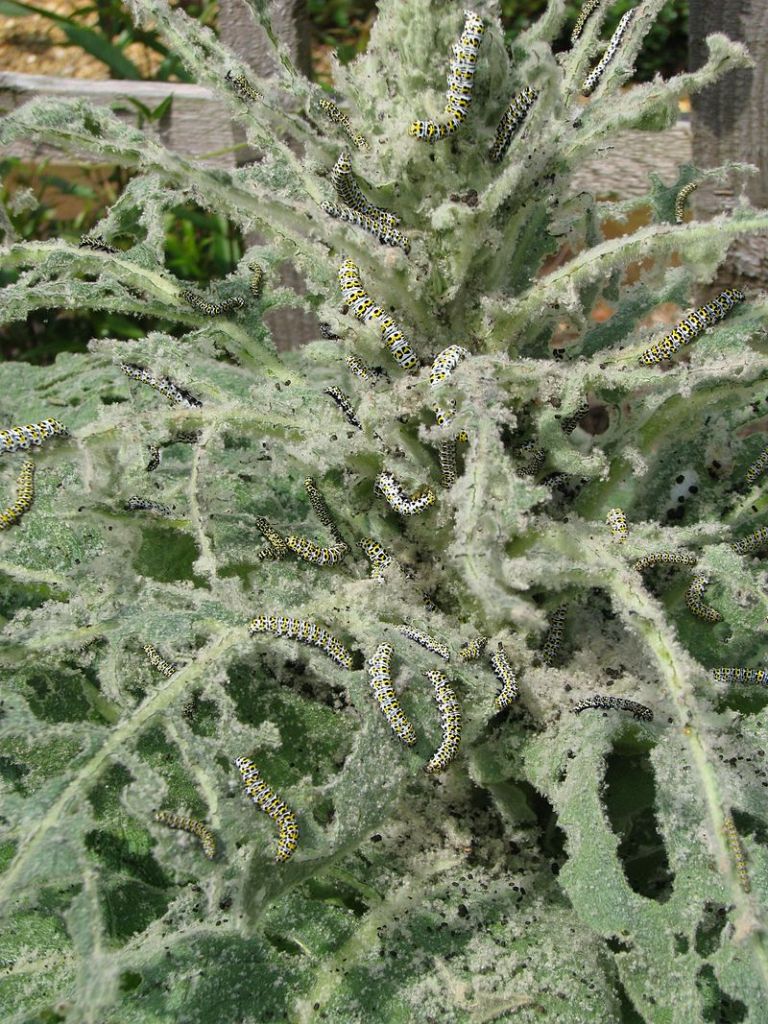
This native plant makes and attractive statement for the wildlife garden!
A flower is open only for a single day, opening before dawn and closing in the afternoon. While many insects visit the flowers, only some bees actually accomplish pollination. Visitors include halictid bees and hoverflies. It occasiaonally gets stripped by the Mullein moth caterpillar!
- Some North American Indian tribes used the woolly leaves as lining to insulate their moccasins against the cold – early settlers learnt of this practice and placed the leaves inside their stockings.
- Its long bare stems were dried and dipped in tallow to make torches and lamp wicks.
- Roman ladies dyed their hair a golden colour with an infusion of the flowers.
- Vernacular names include Aaron’s Rod, Hagtapers, Adam’s flannel, Our Lady’s candle, as well as a number of names that evoke its softness: Donkey’s ears, Duffle, Hare-s-beard, and Rag-paper. A more modern and practical nickname is ‘the Andrex plant’ and its leaves have been used accordingly!
An aromatic, slightly bitter tea can be made by infusing the dried leaves in boiling water for 5 – 10 minutes. A sweeter tea can be made by infusing the fresh or dried flowers.
Great mullein is a commonly used domestic herbal remedy, valued for its efficacy in the treatment of pectoral complaints. It acts by reducing the formation of mucus and stimulating the coughing up of phlegm, and is a specific treatment for tracheitis and bronchitis.
Internal Uses:
An infusion is taken internally in the treatment of a wide range of chest complaints and also to treat diarrhoea.
External Uses:
- A poultice of the leaves is a good healer of wounds and is also applied to ulcers, tumours and piles.
- An infusion of the flowers in olive oil is used as earache drops, or as a local application in the treatment of piles and other mucous membrane inflammations.
- This infusion is also strongly bactericidal.
- A decoction of the roots is said to alleviate toothache and also relieve cramps and convulsions.
- The juice of the plant and powder made from the dried roots is said to quickly remove rough warts when rubbed on them. It is not thought to be so useful for smooth warts.
- The seeds are slightly narcotic and also contain saponins.
- A poultice made from the seeds and leaves is used to draw out splinters.
- A decoction of the seeds is used to soothe chilblains and chapped skin.
- A homeopathic remedy is made from the fresh leaves.
- It is used in the treatment of long-standing headaches accompanied with oppression of the ear.
- A yellow dye is obtained from the flowers by boiling them in water. When used with dilute sulphuric acid they produce a rather permanent green dye, this becomes brown with the addition of alkalis.
- The down on the leaves and stems makes an excellent tinder when quite dry.
- It is also used as an insulation in shoes to keep the feet warm and to make wicks for candle.
- One report says that the leaves contain rotenone, though it does not say in what quantity. Rotenone is used as an insecticide[K].
- Dynamic accumulator.
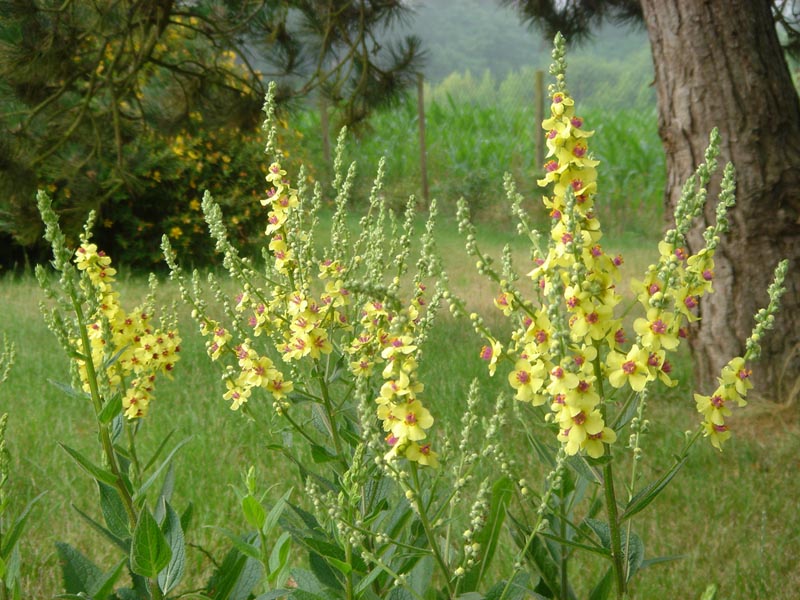
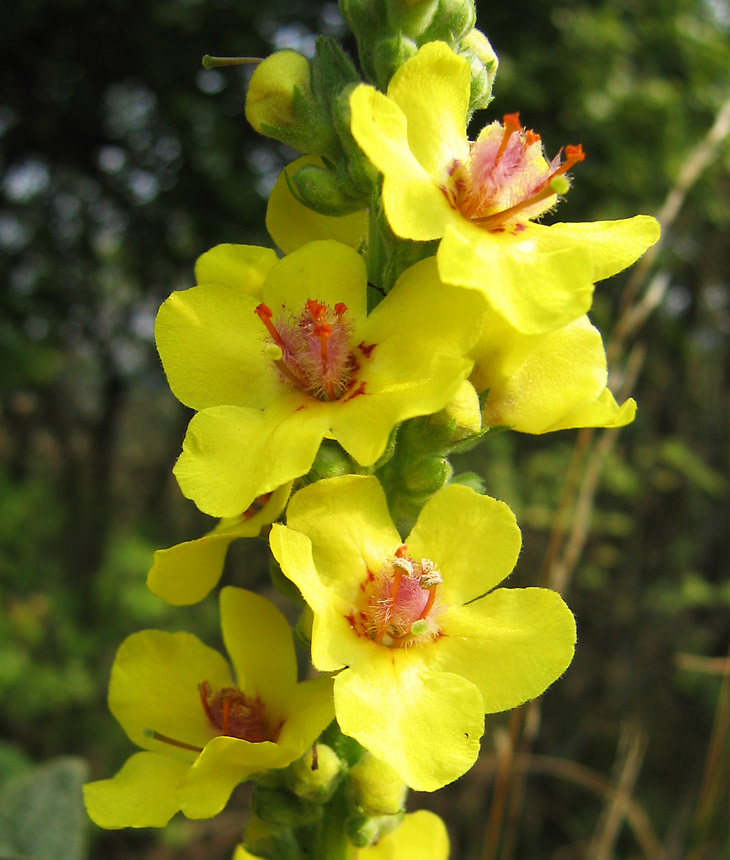
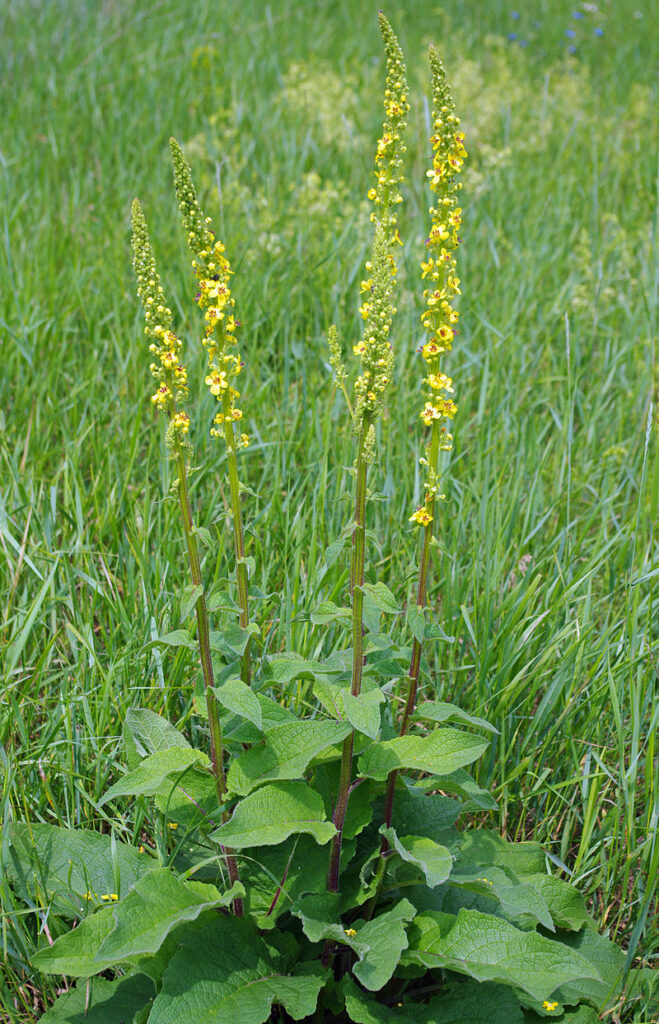
V. nigrum or Dark Mullein in close up and in habitat (by Christian Fischer) in Wikipedia
V. nigrum or Dark Mullein
This biennial or short-lived perennial herb is found on road verges and embankments, in hedge banks and other grassy places, on walls and in cultivated ground, including arable field margins. It prefers well-drained calcareous soils.
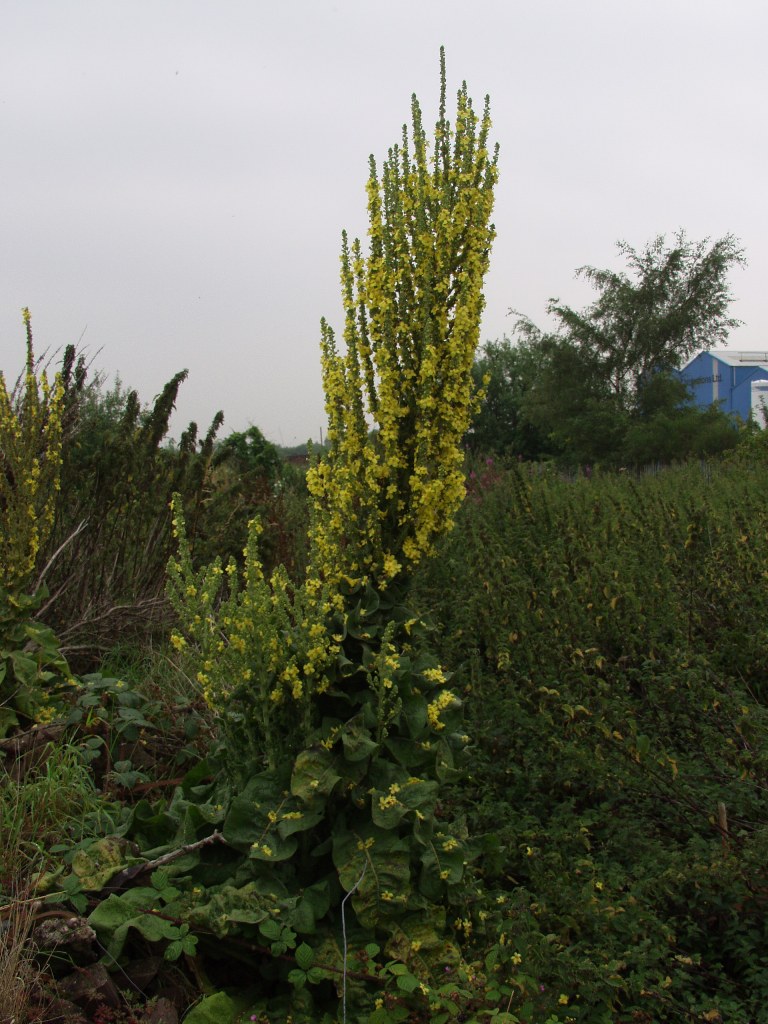
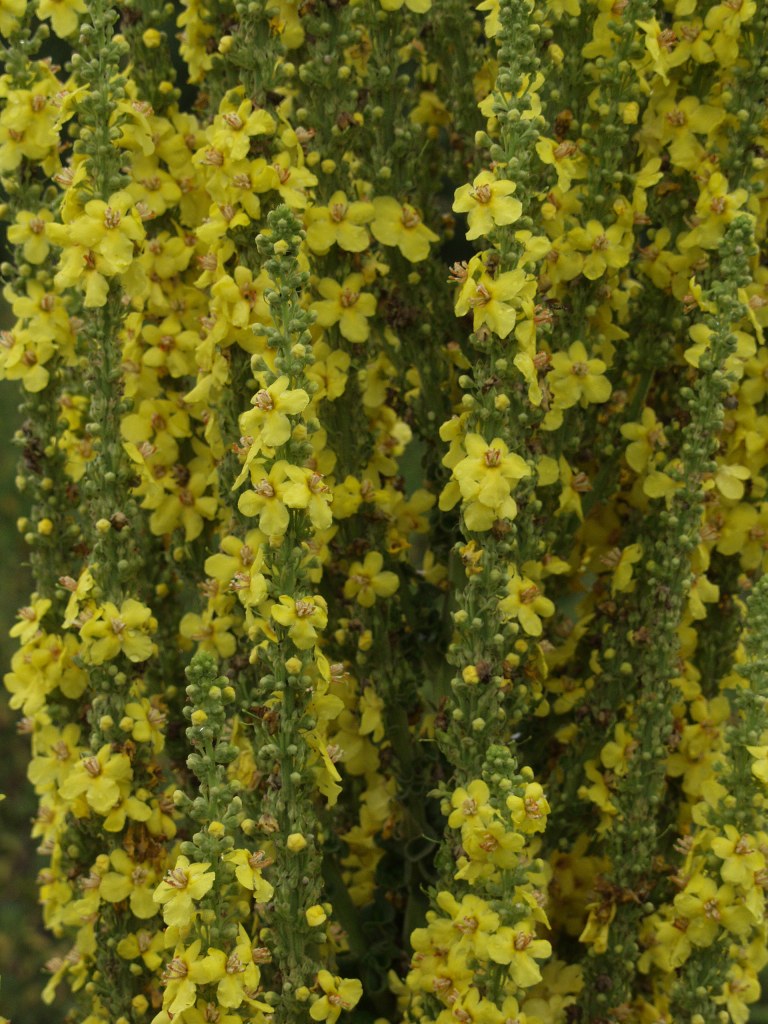
- V. speciosum or Hungarian Mullein (probably the finest species according to Stace))
V. pulverulentum or Hoary Mullein
This monocarpic perennial is found on roadside verges and railway banks, in old quarries and gravel-pits, in hedge banks, rough ground, and locally on coastal shingle (its only `natural` habitat). Outside its core area it is usually a casual of waste ground. Seed remains viable for many years and new populations can appear after soil disturbance.
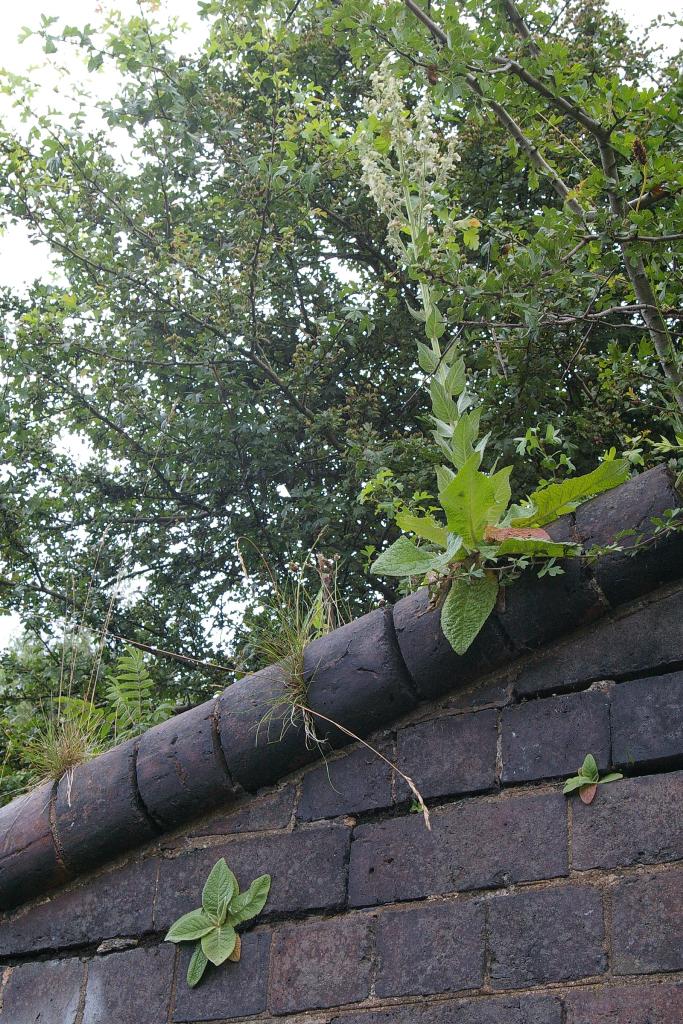
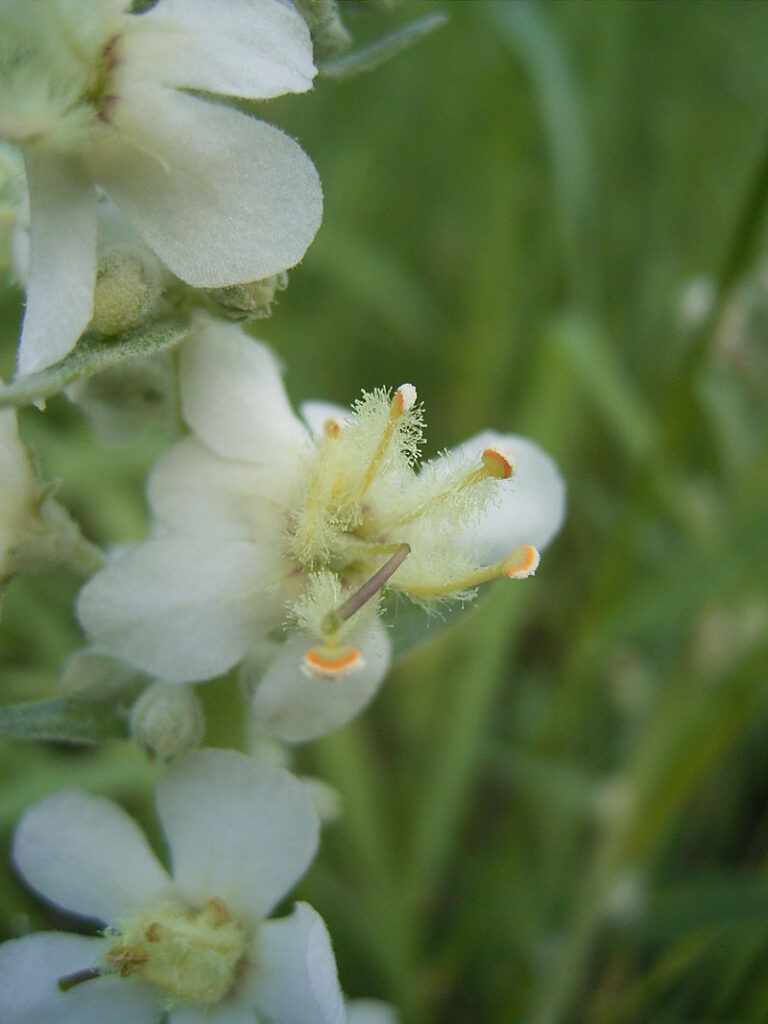
V. lychnitis or White Mullein on a derelict railway bridge at Brockmoor (by M.P.)
V. lychnitis or White Mullein
A biennial, or occasionally short-lived perennial, herb of dry, usually calcareous soil, occurring in rough pastures, recently cleared woodland, on railway embankments, tracksides and road verges and in quarries and waste places. Seed is copiously produced, and remains viable for many years. It freely hybridises with other Verbascum species.
Scrophularia or Figworts
4 native and 3 Introduced & Naturalized species. Flowers are all very similar in each species so they are not easy to identify on just the flowers alone.
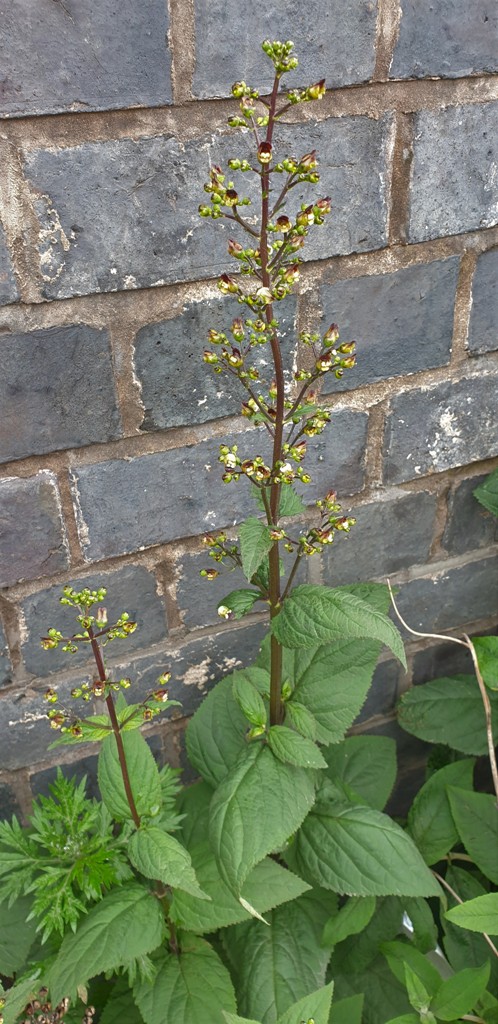
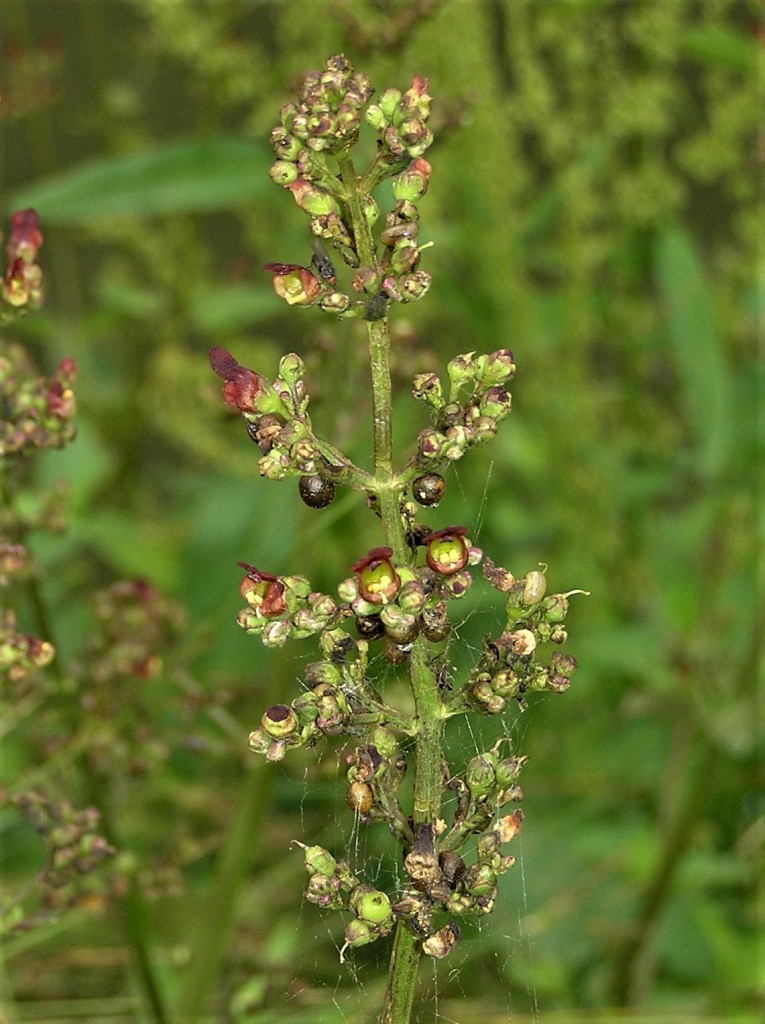
S. nodosa or Common Figwort in habitat (by M.P.) and a close-up showing damage of Figwort Weevil? (by R.P.)
S. nodosa or Common Figwort
A perennial herb of open or shaded habitats, preferring fertile soils and found in damp woodland, woodland rides, hedge banks, ditches and riversides, and sometimes in drier sites on waste ground.
The Romans were fond of eating figs which also was their slang for piles. They named this plant after the swollen nodes of the rhizomes and for its application to tumours as much as to piles. The corolla lobes are swollen too: Scrofula is an old term for disease with glandular swellings. Nowadays herbalists use this plant for skin diseases. (from The Medicinal Flora of Britain and Northwestern Europe by Julian Barker)
Knotted figwort is a plant that supports detoxification of the body and it may be used as a treatment for various kinds of skin disorders.
A decoction is applied externally to sprains, swellings, burns, inflammations etc, and is said to be useful in treating chronic skin diseases, scrofulous sores and gangrene. The leaves can also be applied fresh or be made into an ointment.
Internally, the plant is used in the treatment of chronic skin diseases (such as eczema, psoriasis and pruritis), mastitis, swollen lymph nodes and poor circulation. It should not be prescribed for patients with heart conditions. The root is anthelmintic.
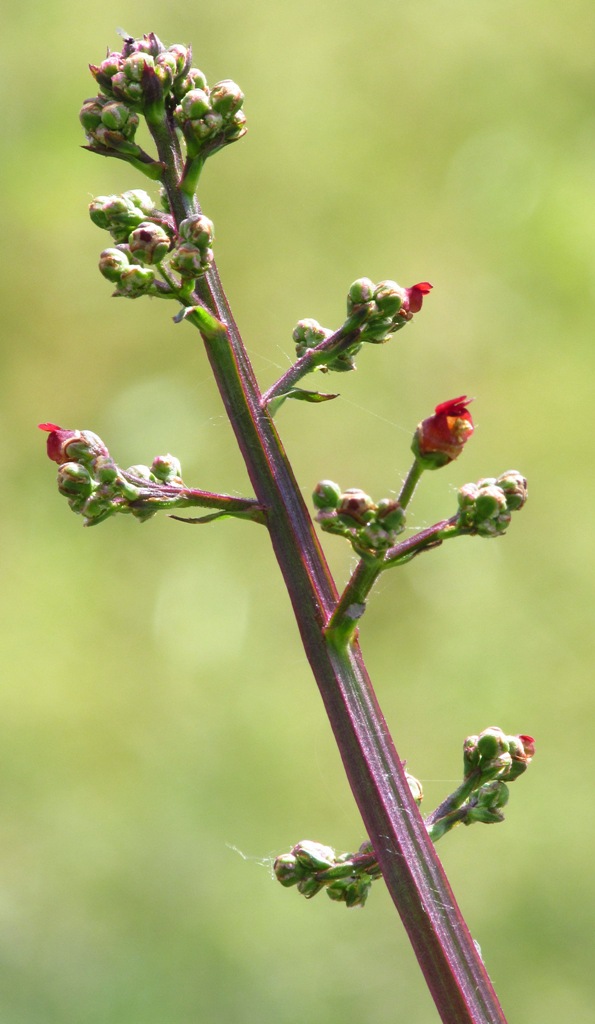
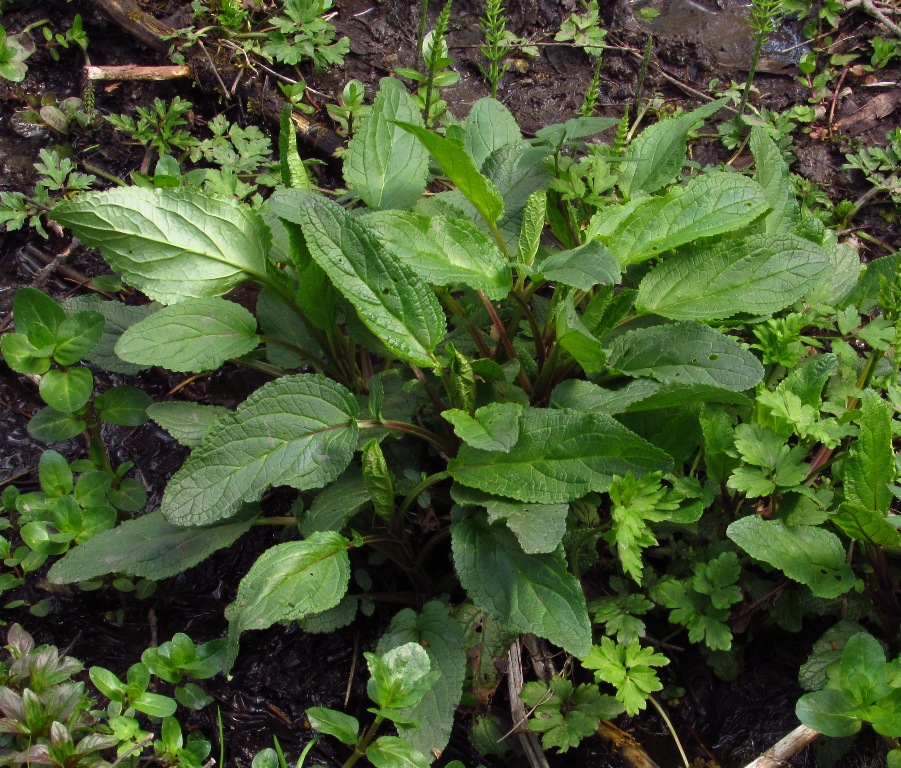
S. auriculata or Water Figwort close-up as well as in its preferred habitat! (by M.S.)
S. auriculata or Water Figwort
A perennial herb of wet places on the margins of lakes, rivers, streams and canals, and in ditches, marshes and wet woodlands.
Very similar to the above species and has similar qualities as S. nodosa above.
S. umbrosa or Green Figwort
A rhizomatous perennial herb which grows on fertile soils by streams and rivers, and in damp woodland, in both open and shaded places.
The plant is probably poisonous to cows.
Very similar to the above species and has similar qualities as S. nodosa above.
S. scorodonia or Balm-leaved Figwort (Neophyte)
A long-lived perennial herb of hedge banks, scrubby field-borders, rough ground on cliff-tops, waste places, disused quarries and old walls.
- S. scopolii or Italian Figwort
- S. vernalis or Yellow Figwort (Neophyte)
A biennial, sometimes perennial, herb found in woodland clearings, plantations, hedge banks and rough waste ground, usually in shade.
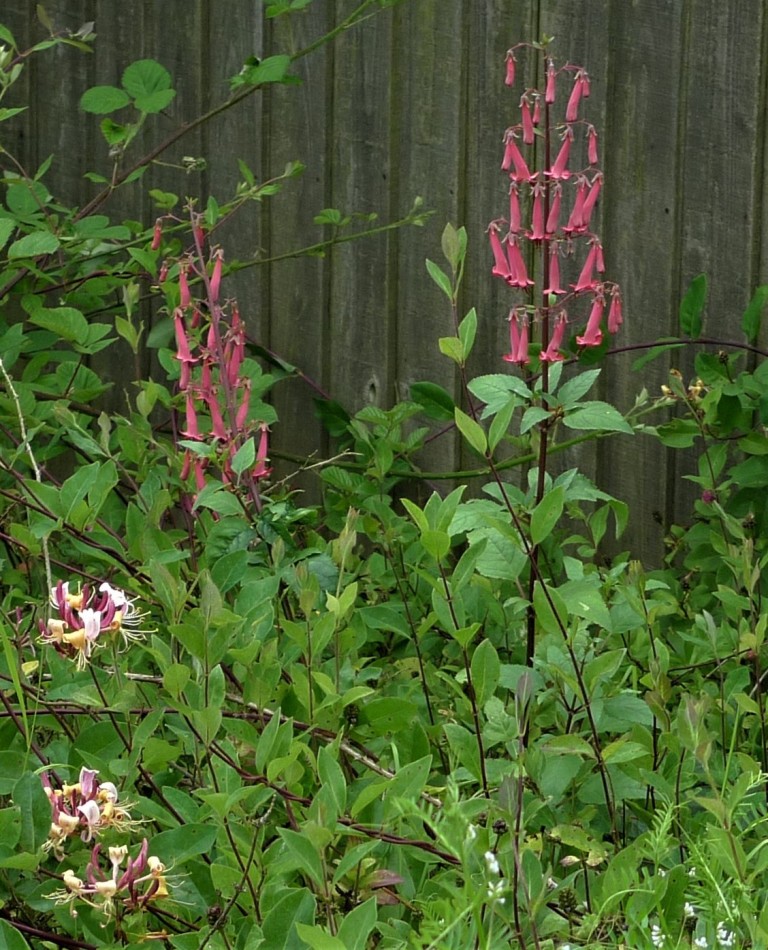
Phygelius capensis or Cape Figwort
Phygelius capensis, the Cape figwort or Cape fuchsia, is an attractive garden plant, native to South Africa. Apparently it grows easily from seeds, hence its escape into the wild!
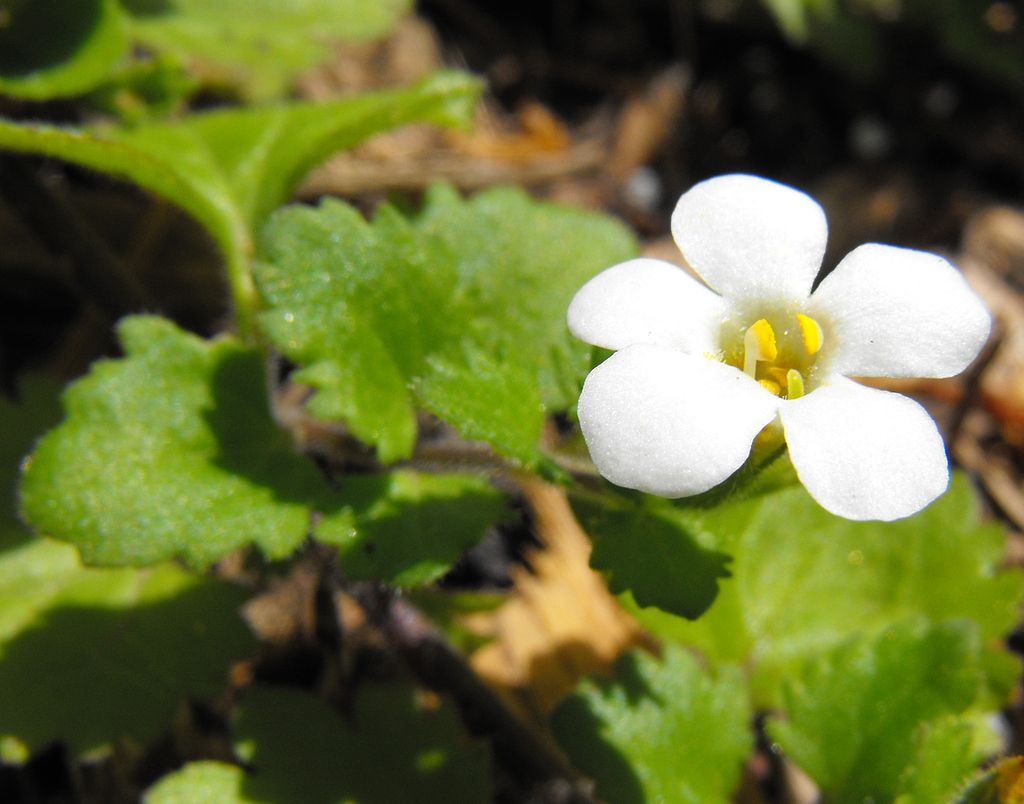
Chaenostoma cordatum (syn. Sutera cordata) or Bacopa
Chaenostoma cordatum, also known as Sutera cordata or Bacopa (not the genus Bacopa), is one of 52 species in the genus Chaenostoma, and is native to South Africa. It is a fast growing bedding plant, especially good for hanging baskets.
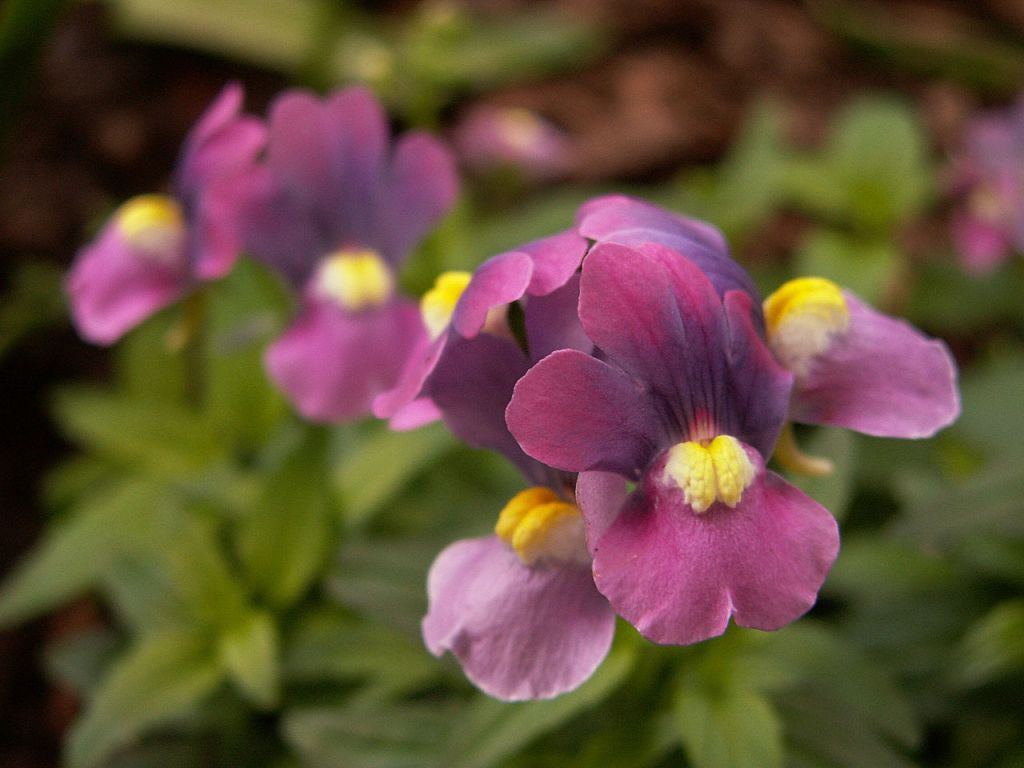
Nemesia spp. and here
Nemesia is a genus of annuals, perennials and sub-shrubs which are native to sandy coasts or disturbed ground in South Africa. Numerous hybrids have been selected, and the annual cultivars (such as shown above) are popular with gardeners as bedding plants . In temperate regions they are usually treated as half-hardy, grown from seed in heat, and planted out after all danger of frost has passed.
Nemesia strumosa or Cape Jewels has been found in the Birmingham and Black Country.
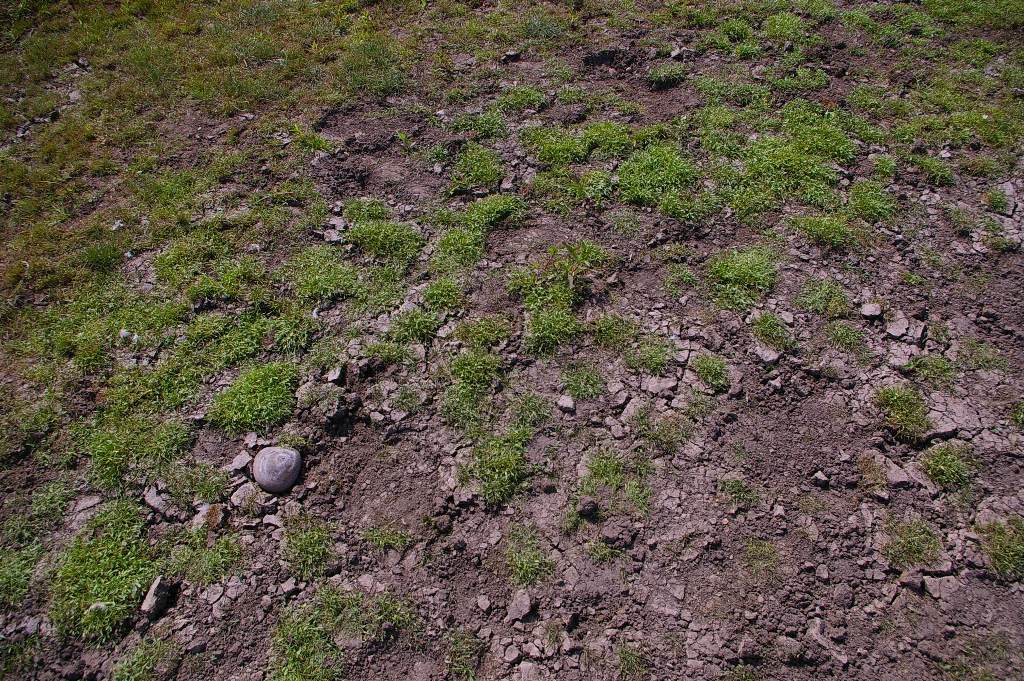
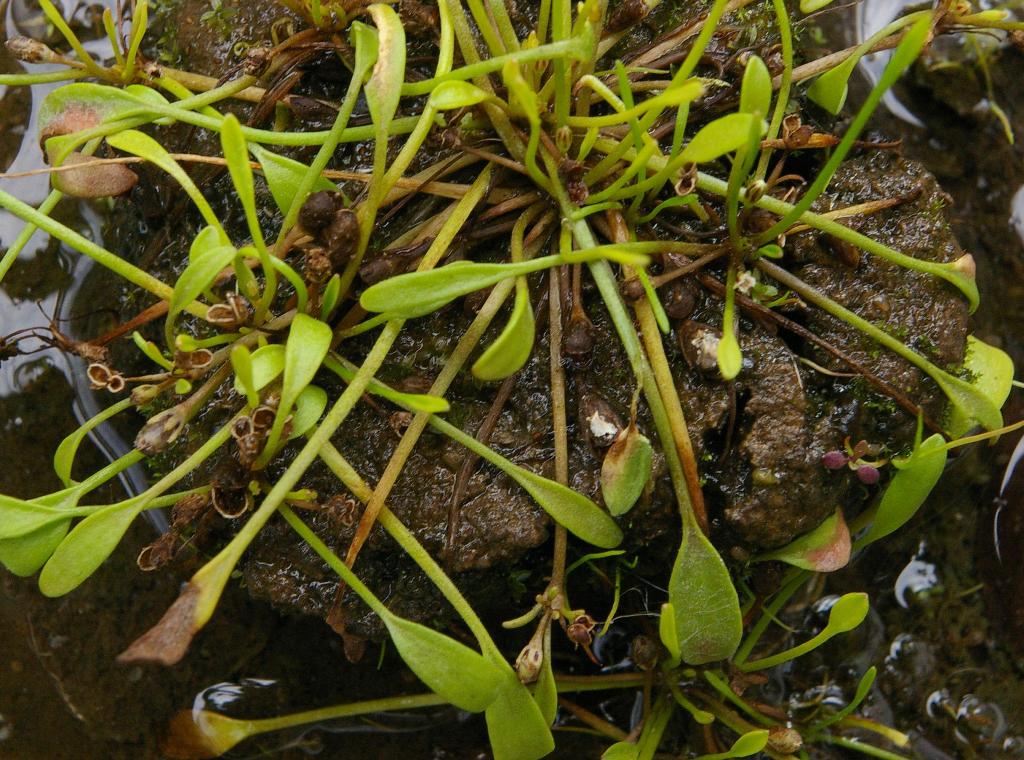
Limosella aquatica or Mudwort
An annual of the muddy edges of rivers, lakes, reservoirs, pools, ditches, rutted tracks and roadsides. In the Burren (Co. Clare) it also occurs in limestone solution hollows. It may prefer mildly acidic, nutrient enriched soils. Plants reproduce by seed and also spread by stolons.
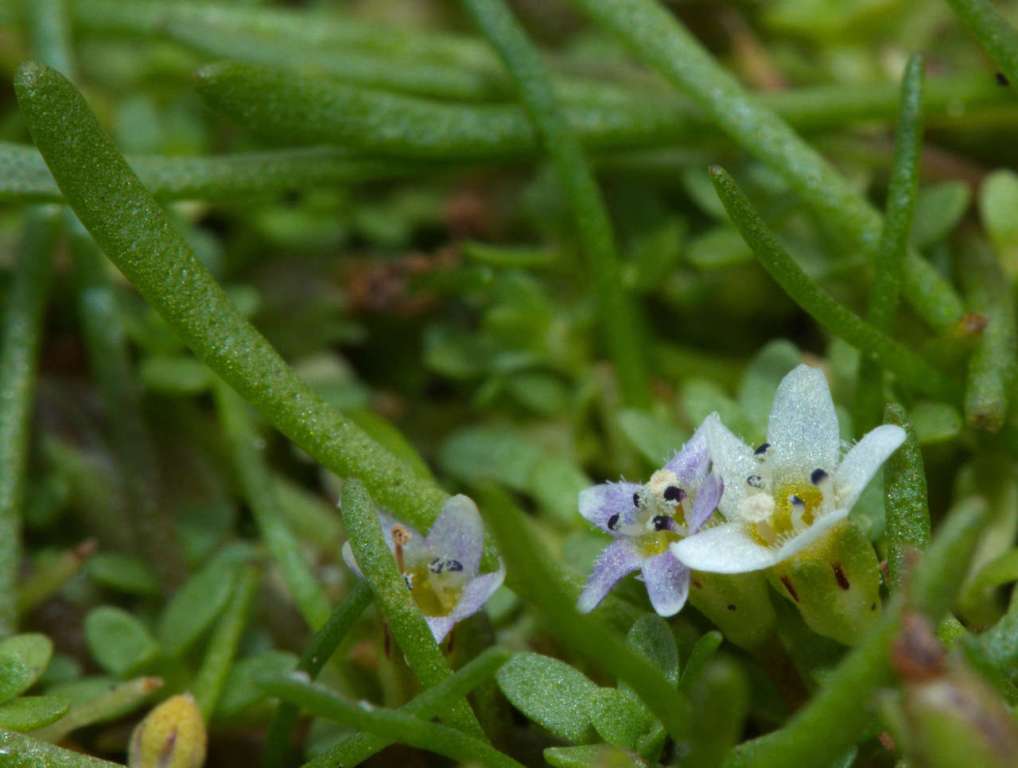
L. australis or Welsh Mudwort
An annual to short-lived perennial of mudflats and saltmarsh pools, occurring as scattered plants or in dense swards. Much less common than species above.
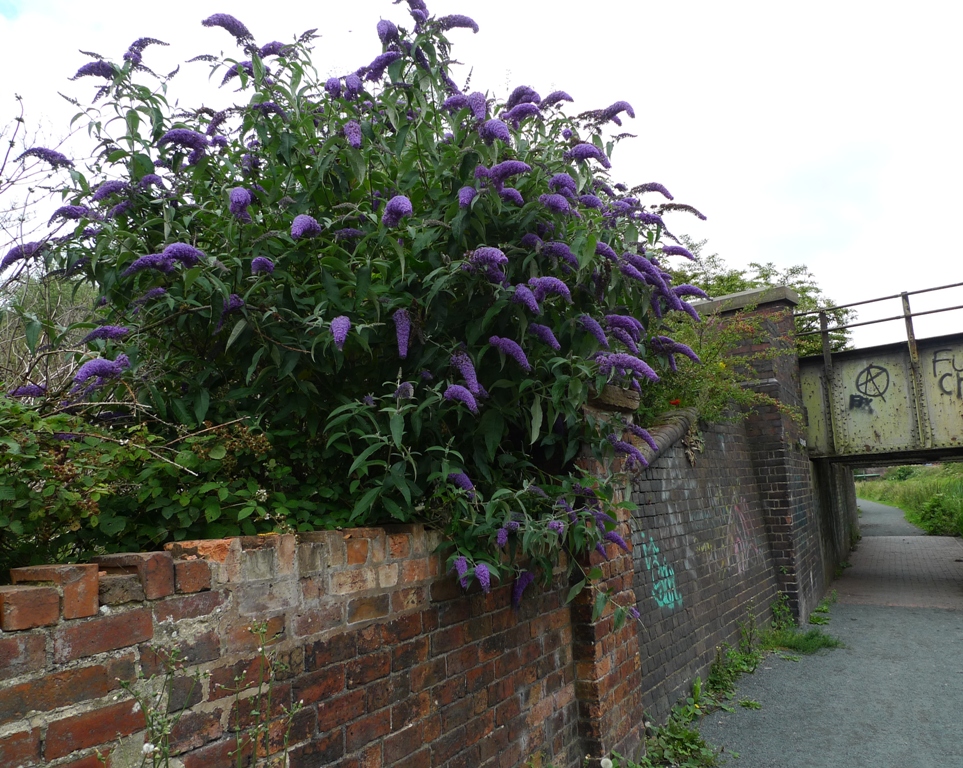
Buddleja or Butterfly-bushes
Buddleja is a genus comprising over 140 species of flowering plants endemic to Asia, Africa, and the Americas. The generic name bestowed by Linnaeus posthumously honoured the Reverend Adam Buddle (1662–1715), an English botanist and rector, at the suggestion of Dr. William Houstoun. Houstoun sent the first plants to become known to science as buddleja (B. americana) to England from the Caribbean about 15 years after Buddle’s death.
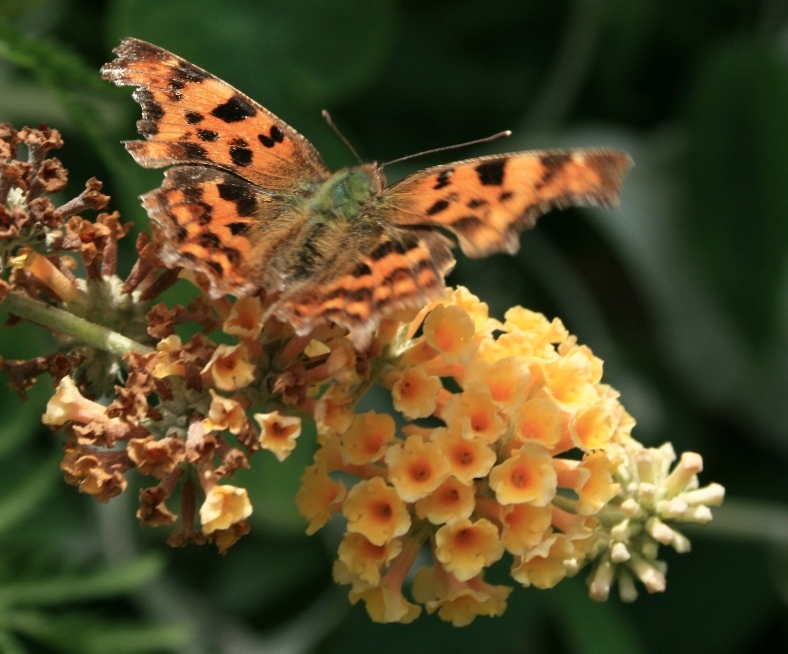
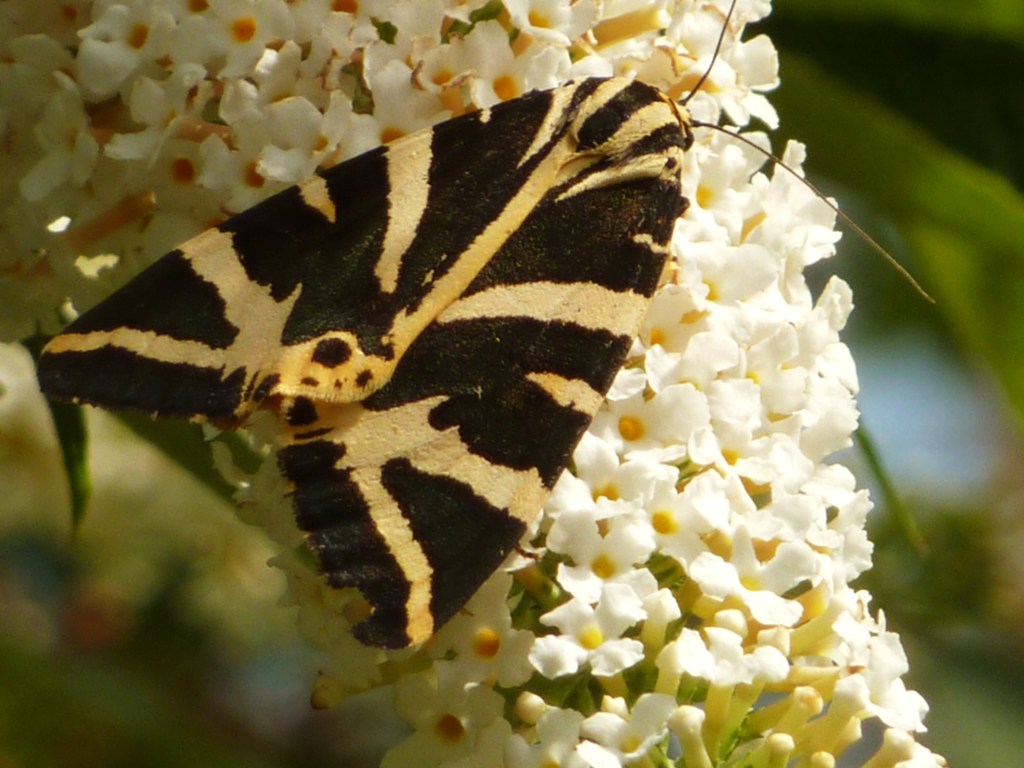
As garden shrubs, buddlejas are essentially 20th-century plants, with the exception of B. globosa which was introduced to Britain from southern Chile in 1774 and disseminated from the nursery of Lee and Kennedy, Hammersmith.
Several species are popular garden plants and are commonly known as “butterfly bushes”, owing to their attractiveness to butterflies, and have become staples of the modern butterfly garden; they are also attractive to bees and moths.
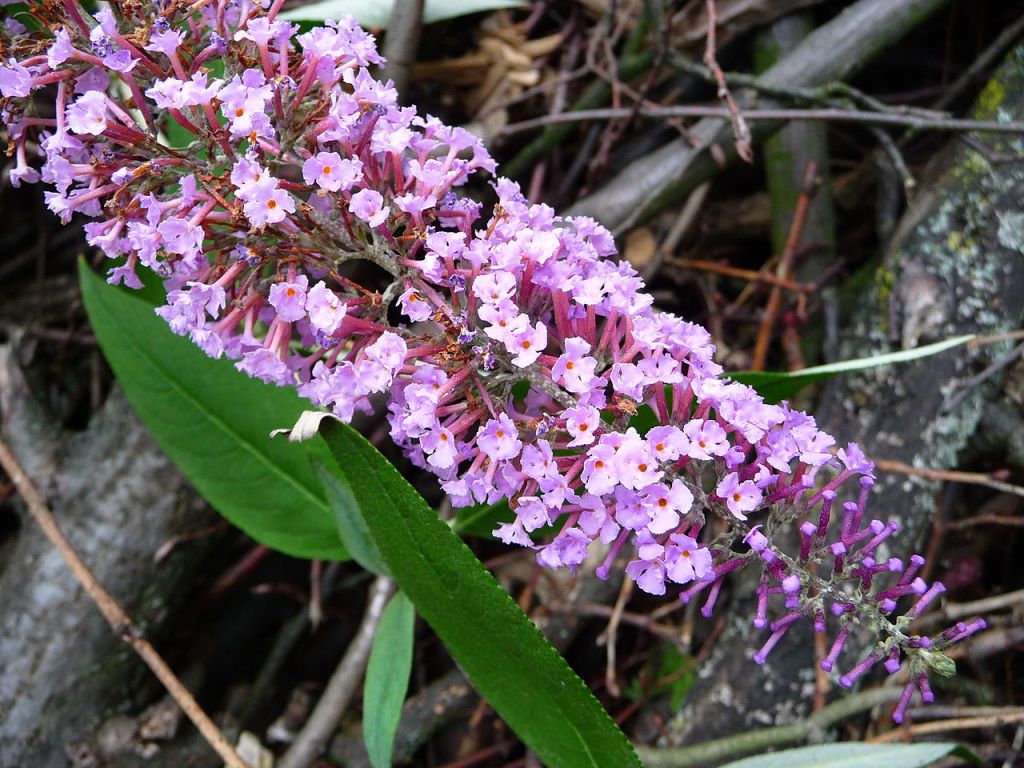
B. davidii or Butterfly-bush
A large deciduous shrub, now very well established on waste ground, by railways, in quarries, on roadsides and generally in urban habitats, where it often grows on walls and neglected buildings. It prefers dry, disturbed sites where large populations can develop from its wind-dispersed seed.
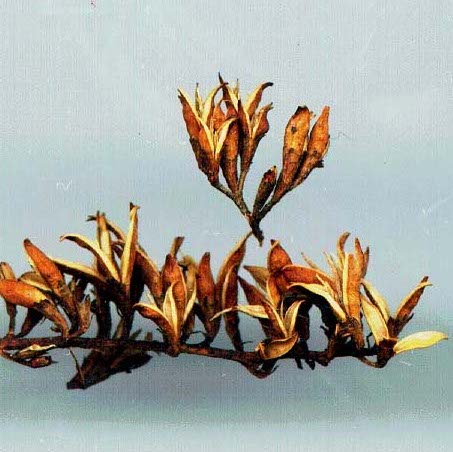
B. davidii was introduced into cultivation from China, in the 1890s, and quickly became very popular in gardens. It was known to be naturalised in the wild in Merioneth by 1922 and Middlesex by 1927, and shown as locally well established in S. England in the 1962 Atlas. In recent decades it has spread rapidly throughout lowland Britain and, to a lesser extent, Ireland.
Buddleja davidii is a fast-growing and undemanding shrub. It has many beautiful cultivars (see website here) and it’s ideal for a growing in wide range of situations, providing they are sunny and the soil is well-drained. The long, heavy flowering heads make a stunning late-summer display for four to six weeks, attracting clouds of butterflies and other insects.
B. davidii was accorded the RHS Award of Merit (AM) in 1898, and the Award of Garden Merit (AGM) in 1941. There are 4 National Collections on the B.I. and here is one of them.
B. davidii was first documented as an invasive species in the United Kingdom during 1922. It can be seen along railway lines and on the sites of derelict factories and other buildings.
It is a costly plant, especially for the British Railways! It can even grow between the bricks on buildings! The plant frequently grew on urban bomb sites during the aftermath of World War II, earning it the nickname of “the bomb site plant”
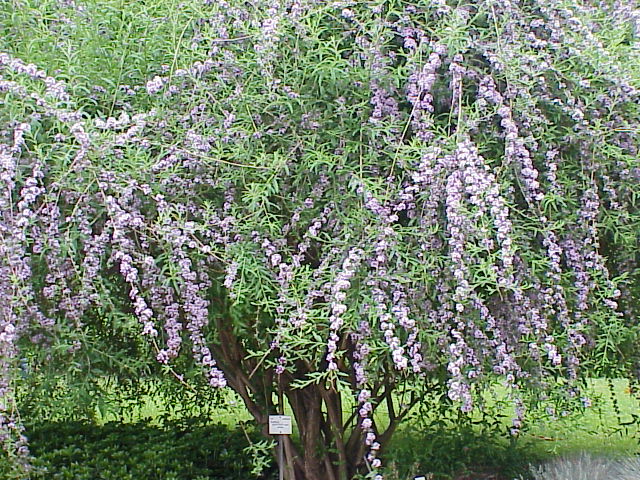
A large deciduous shrub with long, arching branches. It is planted in woodland and amenity areas, and also occurs as a garden escape in woodland, hedges and on banks.
Buddleja alternifolia, found wild in Chinese hedgerows, is different to the more familiar Buddleja davidii. Its branches are more slender, arching or weeping almost to the ground, with leaves appearing in early summer. Dense clusters of soft lilac-purple or pink fragrant flowers stud the full length of the previous year’s stems. As with Buddleja davidii, its flowers are a magnet for butterflies and other pollinators. It can be trained against a wall or grown as a delightful weeping standard. The Royal Horticultural Society has given it its prestigious Award of Garden Merit (AGM).
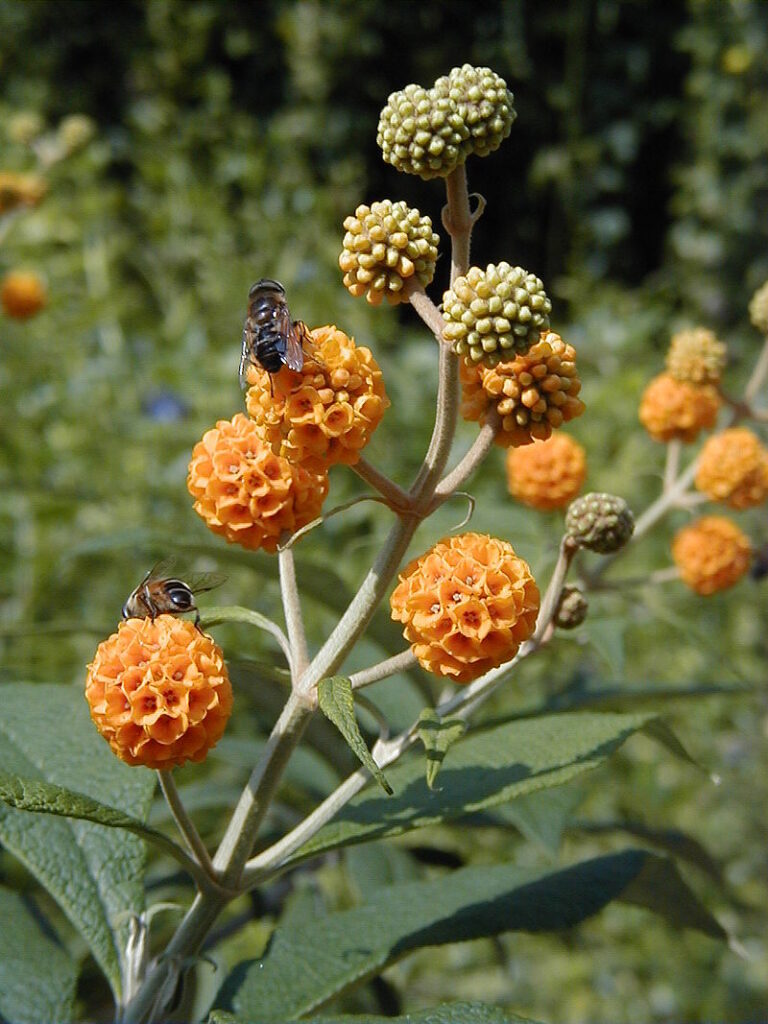
A large deciduous shrub, found as a garden escape or throw-out on roadsides and waste ground, and as a relic of cultivation. Reproduction is by seed but the species is rarely naturalised.
Buddleja globosa was first introduced to the United Kingdom from Chile in 1774, and is now commonly grown as an ornamental garden shrub. Unlike B. davidii, introduced over a century later, B. globosa is not invasive owing to its wingless seeds.
The plant was accorded the Royal Horticultural Society‘s Award of Garden Merit in 1993 and has several cultivars.
Folk medicine attributes to B. globosa wound healing properties, and the infusion of the leaves is used topically for the treatment of wounds, burns and external and internal ulcers.
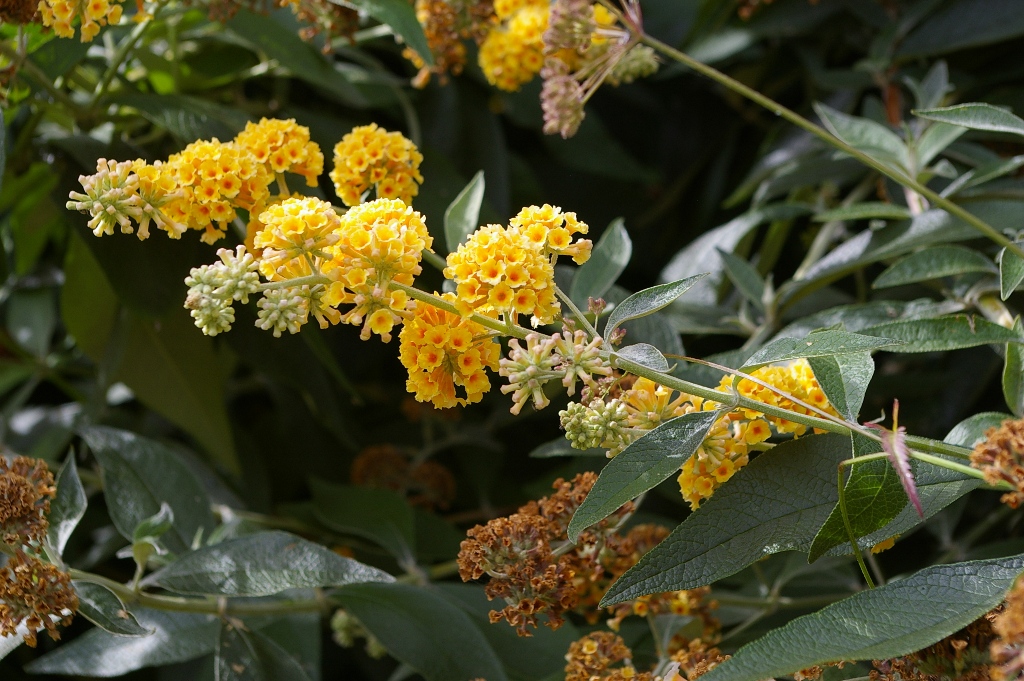
A deciduous shrub which occurs as a naturalised garden escape in hedgerows and on roadsides and rough ground.
This hybrid was first raised in Dorset in 1914, and is occasionally grown in gardens. It was first recorded from the wild in 1976 (W. Cornwall), and is probably under-recorded.
Buddleja × weyeriana ‘Golden Glow’ is the original plant of van de Weyer exhibited in 1920. A specimen is grown as part of the NCCPG national collection held by the Longstock Park Nursery together with the cultvars ‘Sungold’, ‘Moonlight’, and B. × weyeriana ‘Variegata’.
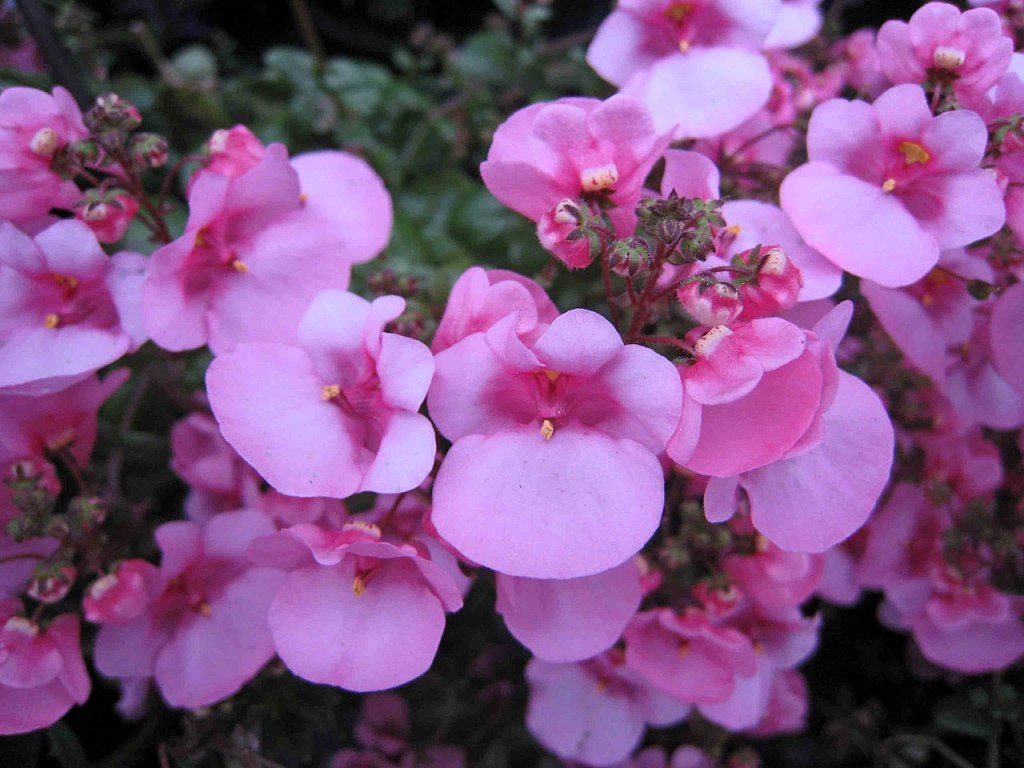
Diascia barbarae or Twinspur
The last plant genus in the Figwort Family is another tender, perennial garden plant from Souh Africa. Mostly cultivars are grown in gardens.
